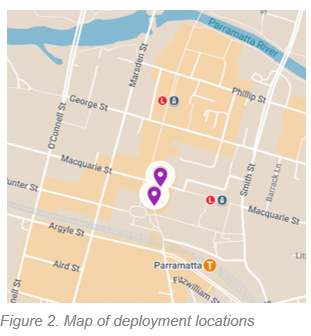Harnessing IoT sensor data for institutional and community impact
| Dates | November 2021 - May 2023 |
| Locations | Parramatta CBD |
| Issue | Road traffic emissions, bushfire smoke |
| Sensing devices | 2 AQMesh air quality monitors |
| Data measured | Temperature, humidity, particulate matter, NOx, SOx, CO, O3, CO2 |
| Communications technology | 4G (LTE) |
"The data that we collect from the sensors is shared with the NSW government and this will help us to manage the city in a better way. There is [also] a network of Councils where we share and talk about this data, and how this will impact our communities in each of the Council areas, to improve quality of life within our communities.”– Sameer Pandey, Lord Major (2023)

The City of Parramatta has been recognised as a forward-thinking leader on smart city strategy and implementation within the Australian local government sector for the past decade and was no stranger to smart low-cost air quality monitoring when it joined the OPENAIR program. Council focused its’ OPENAIR work on development of a city-wide data management and integration strategy and uplift of internal guidance and procurement processes for future smart sensing initiatives. Two new air quality monitoring stations were installed in the Parramatta CBD as part of the project, with the aim of improving understanding of localised air quality related to transport emissions and CBD air quality generally.
Why did Council focus on this issue?
The City of Parramatta‘s participation in the OPENAIR program was driven by its Smart City Masterplan (2015) and supported its’ Community Strategic Plan (CSP). Although the CSP does not explicitly mention air quality monitoring, it emphasises fostering a healthy and resilient community and environment and implementing Smart City initiatives to enhance data-driven decision-making and improve residents' experiences. With 87 smart air quality sensing devices already deployed and multiple standalone smart sensing systems in operation by different business units, the Council recognised the underutilisation of their existing data resources. The priority for their OPENAIR pilot project was to build on these foundations of data collection, management, and analytics to improve what the Council sees, enhance community engagement with data, and enrich the experience of people interacting with data and making decisions based upon it.
Who was involved in the planning and delivery of the pilot?
The project was led by two Senior Project Officers in the City Strategy Team, with direct support from Council’s Future City Unit, which was developed to drive forward a city-wide smart city strategy. Council’s data analyst also provided valuable input. The Lord Mayor was actively supportive of the project and appeared in the OPENAIR Documentary
The technology
Council was operating a wide variety of different air quality monitoring technologies when they joined OPENAIR. These were mostly standalone systems with disparate, siloed data repositories. Several past and current initiatives sought to integrate data resources into a single accessible location such as a ‘Data Visualisation Hub’ or ‘data lake’. In choosing new low-cost sensing technology for OPENAIR, it was important to Council that the solution had high interoperability that would enable seamless integration of live data with their own internal systems. Council also lacked a suitable existing private communications network for the locations of interest, causing them to focus on options with 4G and NBIoT connectivity.
The AQMesh Air Quality Monitoring System is a mid-performance multi-parameter air quality monitoring device with an extensive global user base, that meets MCERTS (UK Government’s Monitoring Certification Scheme) and US EPA (Environmental Protection Agency) guidelines for low-cost air quality sensors. The AQMesh system has strong interoperability and supported full integration of live data with Council’s existing data platforms and data lake.


Sensing device deployment
Two devices were deployed in the Parramatta city centre, either side of Centenary Square. The area has experienced major development in recent years, has very high foot traffic and a new light rail system.
The council wanted to gather hyperlocal air quality data to understand how transport emissions are impacting ambient air quality in this high-rise inner-city context at different times of the day and the year, and under various weather conditions.
Devices were mounted onto the external channels of Council-owned smart poles.
Challenges and lessons learned
Staff turnover
Council staff leading the OPENAIR pilot project have since left the organisation, resulting in loss of some knowledge, insights and connections with other OPENAIR councils. Parramatta is not unique in this regard – changes in staffing occur regularly in all organisations. A key response to this challenge was to focus on the integration of data with centrally managed and accessible Council systems, ensuring that the technology and data did not end up siloed and underutilised. The project was also positioned to feed directly into a policy renewal process, helping to improve capture of tacit knowledge.
The operational funding challenge and the role of local government
A common challenge identified by Council is the difficulty in justifying allocation of operational funding required for maintenance of a sensing network, once the initial grant funding period has ended. This challenge occurs against a broader context of resourcing constraints for local government. To justify operational funding of data collection, there must be a clear data use case connected to Council priorities. Here, an aligned challenge becomes apparent; the role of Australian local governments in monitoring and managing localised air quality issues is poorly defined, with no clear regulatory responsibility.
OPENAIR was understood to be a potential way forward in terms of addressing these challenges, due to the focus on data sharing between local and state government. The thinking is that, if state government can develop larger scale use cases for Council-managed air quality data then this can begin to position local governments as valued operational partners within a broader state-led air quality strategy.
Data and insights
About the data
Data from the AQMesh devices has been consistently reliable since installation, with devices continuing to operate at the time of writing. To date, no formal review or interpretation of data has been conducted, due to staff turnover and shifting priorities.
Data sharing
Internal sharing of data was a central theme of Council’s pilot project, with data from the new AQMesh devices integrated with Council’s central data management platform. It was realised that the value of any one smart sensing network is increased through connection to every other network, allowing data to be interpreted in a broader city-scale context.
In acknowledgment of the transboundary nature of air quality, Council began sharing data from the two AQMesh devices with the OPENAIR pilot data platform, hosted by the NSW Department of Climate Change, Energy, Environment and Water (DCCEEW). This was seen as a first step towards adding value to Council data by interpreting it within a broader regional context. As part of this, Council paid close attention to how they labelled and formatted the data from their new devices. They also engaged closely with the OPENAIR cohort to understand how other Councils were approaching this task. DCCEEW plans to make data shared to the OPENAIR platform accessible to the public via the NSW Government’s SEED (Sharing and Enabling Environmental Data) portal.
A stated aim of the project was to openly share real-time air quality data in a way that is useful to the public, with the goal of supporting open innovation. The view was formed that Council should aim to provide quality data with appropriate context that would support community to find and develop their own data use cases. At the time of writing, this is still a work in progress.

Creating impact
The OPENAIR pilot project has resulted in the following positive impacts:
Directly influenced strategy renewal
Council’s involvement with OPENAIR directly contributed to the development of the new Smart City and Innovation Strategy in 2024. This emphasises a ‘data led and innovative organisation’, with a commitment to improve the ways in which Council ‘collects, analyses, uses and maintains data’ and ‘improve data access so that the community can obtain data in an easy and intuitive way’.
Looking ahead
Council is in the process of implementing data governance and integration frameworks and is establishing policies and procedures for effective best practice data management. The real-time data produced by Council’s new air quality monitoring devices provides a focus for pragmatic development of these frameworks, policies and procedures.
An internal data portal is also being developed for 2026, which will be capable of hosting live data from the two monitoring devices, as well as all other environmental monitoring devices being operated by Council. It is hoped that this will improve access to and use of environmental data, supporting a culture of innovation within the organisation and community.